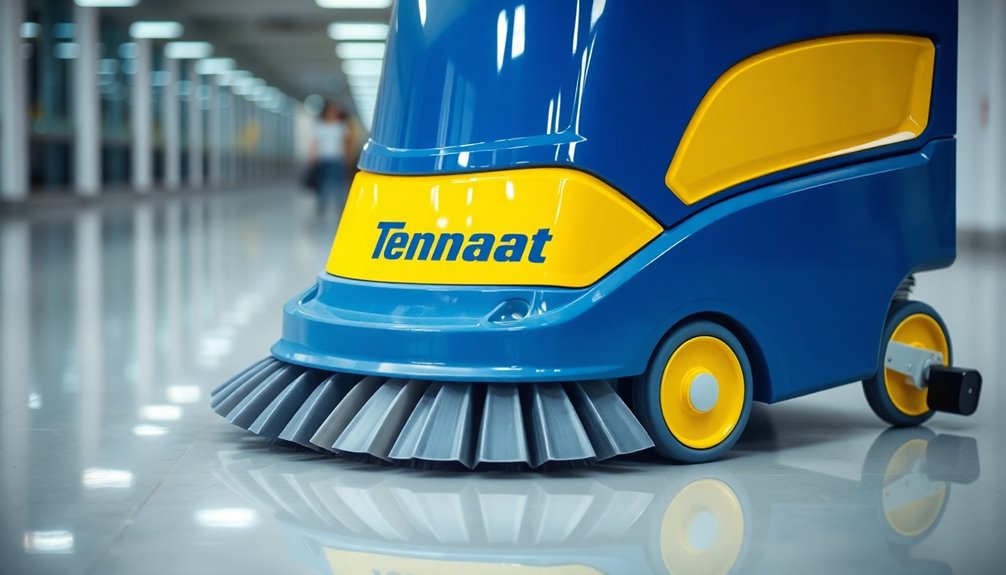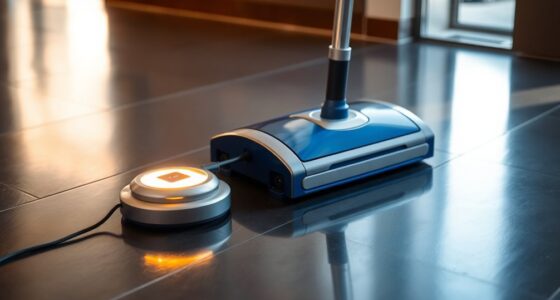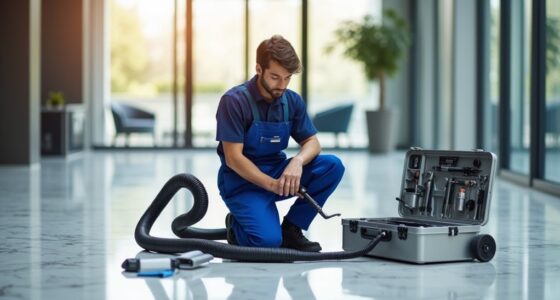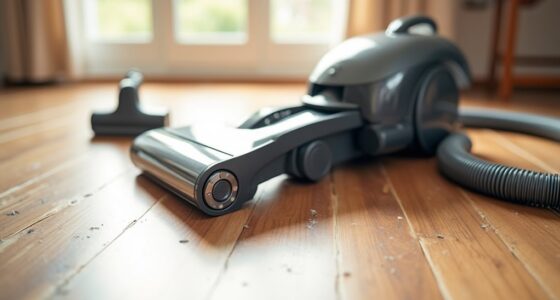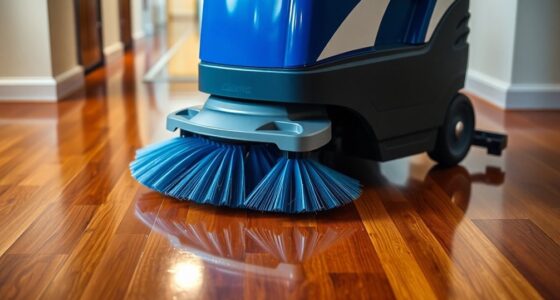To use a Tennant floor scrubber, start by familiarizing yourself with the machine's components and safety precautions. Check the solution tank, scrub brushes, and squeegee condition before operation. Fill the solution tank with water and detergent, then lower the scrub brushes and squeegee. Adjust the solution flow and scrub at a steady speed, ensuring you overlap passes for full coverage. After scrubbing, clean the recovery tank and inspect all components. Keep going to discover maintenance tips and troubleshooting steps!
Key Takeaways
- Ensure the solution tank is filled with water and detergent, leaving 25 mm (1 in) below the fill opening before operation.
- Inspect scrub brushes for wear; replace if bristles are less than 10 mm (3/8 in) for effective cleaning.
- Lower the scrub brushes and squeegee; engage the scrub switch to initiate scrubbing.
- Adjust the solution flow lever for optimal dirt removal while monitoring the solution application during operation.
- After cleaning, raise the scrub brushes and squeegee, then drain and clean the recovery tank to prevent clogs.
Safety Precautions Before Operating the Machine
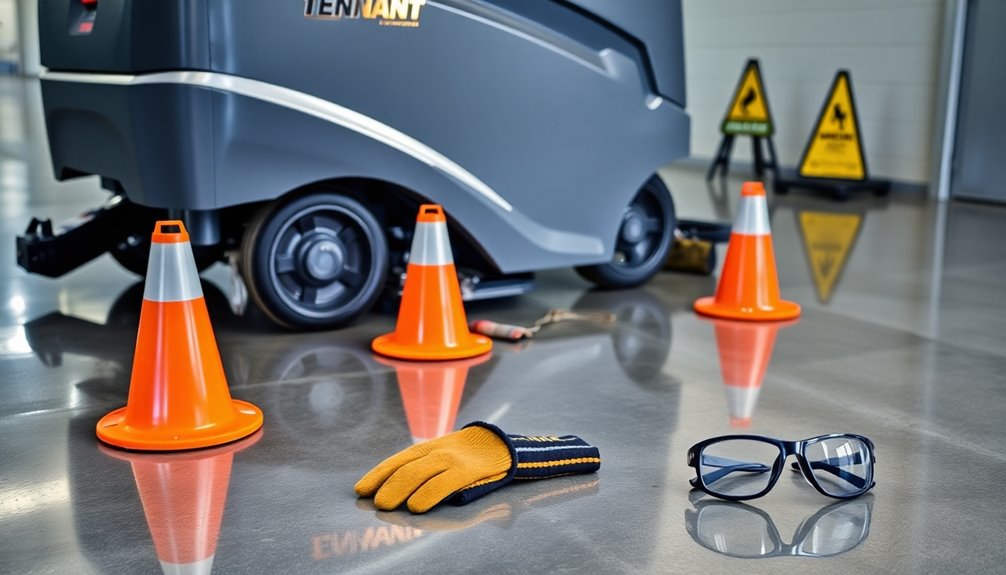
Before you start using the Tennant floor scrubber, it's crucial to prioritize safety. First, read the machine's manual and understand all safety instructions.
Avoid using flammable materials in the solution tank, as this could lead to an explosion or fire. When operating, steer clear of picking up batteries; hydrogen gas can emit and is highly flammable.
Make certain you keep sparks and open flames away, especially during battery charging with the cover open.
Before you begin, inspect the scrubber for any leaks, and check that the recovery tank and vacuum system are functioning properly.
Taking these precautions will help minimize safety hazards and guarantee a smooth scrubbing operation.
Stay safe while achieving clean floors!
Understanding Machine Components
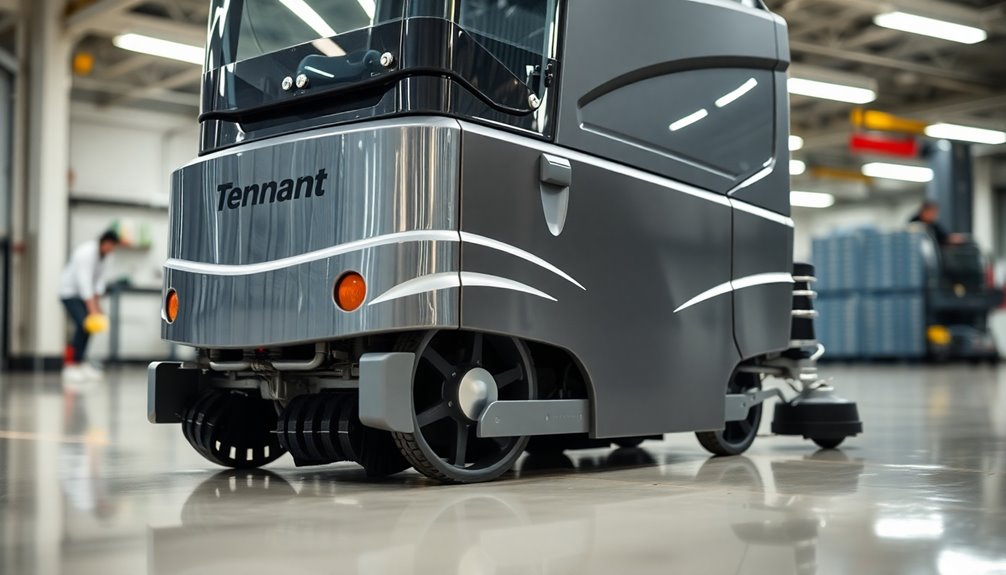
After confirming safety precautions are in place, it's time to familiarize yourself with the components of the Tennant floor scrubber.
The solution tank holds your cleaning solution, so make certain it's filled with water and detergent, leaving about 25 mm (1 in) below the fill opening to prevent overflow.
Next, inspect the scrub brushes, which are essential for agitating the floor and lifting dirt; replace them if their bristles are less than 10 mm (3/8 in) long.
Finally, check the squeegee blade at the rear of the machine. It effectively wipes away dirty solution, but it needs routine inspections for nicks, cuts, or rounded edges to guarantee peak performance.
Understanding these components is fundamental for efficient operation.
Controls and Instrumentation Overview

Understanding the controls and instrumentation of the Tennant floor scrubber is essential for effective operation.
The On/Off key switch powers the machine, with the right position turning it on and the left turning it off. To start using the brushes or pads, press the scrub switch, which lowers the brushes and initiates scrubbing. If you need to stop, pressing the bottom of the switch raises the brushes and halts the action.
Monitor the hour meter for maintenance scheduling, and keep an eye on the battery discharge indicator for the power level. The solution flow lever adjusts the cleaning solution; moving it forward increases the flow, while backward decreases it.
Pre-Operational Checks

Before you start using the Tennant floor scrubber, make certain to inspect the machine for any leaks under the solution and recovery tanks.
Check the squeegee's condition to guarantee it's in good shape, and verify the solution tank is filled correctly with water and detergent.
These pre-operational checks are essential for safe and effective scrubbing.
Inspect for Leaks
To guarantee your Tennant floor scrubber operates effectively, it's important to inspect for leaks during your pre-operational checks. Start by looking under the machine for any signs of leaks, especially around the solution and recovery tanks. These leaks can hamper your cleaning performance. Make certain all hoses and connections are secure, free from cracks or damage, as these can lead to leaks during use. Pay close attention to the squeegee assembly for any fluid buildup that may indicate a problem. Conduct this inspection before every use to maintain safety and peak functionality.
| Area to Inspect | Action to Take |
|---|---|
| Solution Tank | Check for leaks and cracks |
| Recovery Tank | Inspect for fluid accumulation |
| Hoses and Connections | Verify they are secure |
| Squeegee Assembly | Look for fluid buildup |
Check Squeegee Condition
Checking the squeegee condition is essential for guaranteeing effective cleaning and water recovery with your Tennant floor scrubber.
Start by inspecting the squeegee for proper deflection; this guarantees it makes best contact with the floor. Look closely at the squeegee blade for any signs of wear, like rounded edges, nicks, or cuts that could compromise its performance. If needed, adjust the blade deflection to enhance its effectiveness.
Before you begin, confirm the squeegee is securely attached and free from damage to prevent operational issues.
Finally, regularly check for debris or obstructions around the squeegee area, as these can hinder performance while scrubbing.
Taking these steps will help maintain your scrubber's efficiency and reliability.
Verify Solution Tank Contents
Verifying the solution tank contents is essential for guaranteeing your Tennant floor scrubber operates effectively. Start by opening the solution tank cover and visually inspecting the contents. Make sure it's partially filled with water and the right detergent is added. Fill the tank until it's about 25 mm (1 inch) below the fill opening to prevent overflow. Check that the tank is free from debris and contaminants to maintain cleaning performance. Look for any leaks under the machine, as these can indicate plumbing issues. Finally, confirm the scrub head strap is in place for heavy scrub mode if needed.
| Step | Action |
|---|---|
| Inspect Tank | Check for water and detergent levels |
| Fill Water | Maintain 25 mm (1 inch) below the opening |
| Clean Tank | Remove debris and contaminants |
| Check for Leaks | Look under the machine for leaks |
| Secure Scrub Head Strap | Guarantee it's in place for heavy scrub mode |
Preparing the Machine for Scrubbing
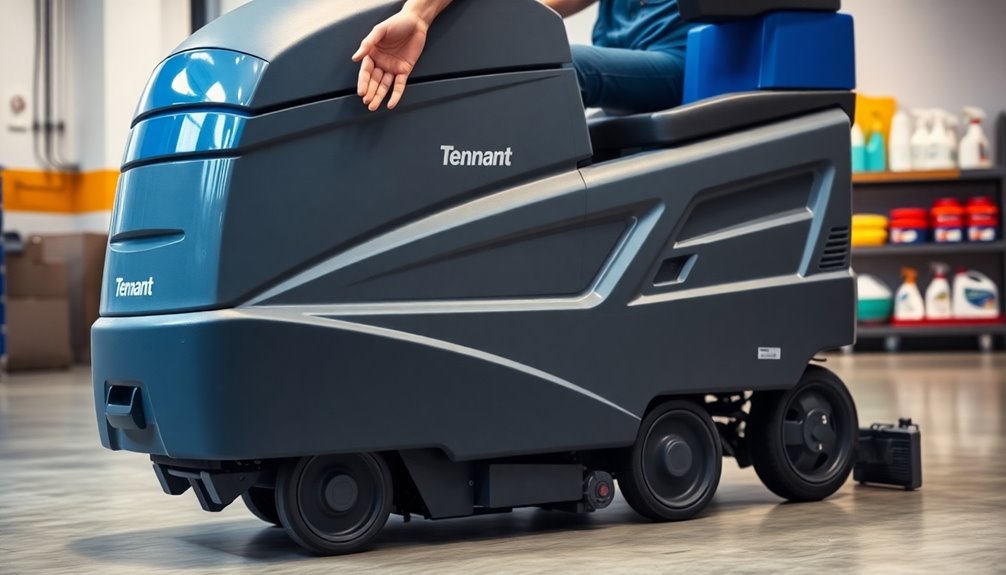
Before you start scrubbing, take a moment to inspect the machine's components for any leaks or issues.
Make certain the squeegee and scrub head strap are in good shape, then fill the solution tank with water and the right detergent.
This preparation will guarantee your floor scrubber operates efficiently and effectively.
Inspect Machine Components
A thorough inspection of the Tennant floor scrubber's components is essential for safe and effective operation. Start by checking for leaks under the machine to avoid hazards.
Next, examine the squeegee for proper deflection and inspect the blade for wear, rounded edges, or cuts. Finally, make sure the scrub head strap is secure, especially if you're using heavy scrub mode.
- Look for debris like wire or string around the scrub brushes to prevent damage.
- Confirm the squeegee is in good condition for efficient water recovery.
- Verify that all components are properly attached and functional before you begin scrubbing.
Fill Solution Tank
To prepare your Tennant floor scrubber for operation, start by opening the solution tank cover and partially filling it with water.
Next, add the required detergent according to the manufacturer's instructions. Fill the solution tank until it's about 25 mm (1 inch) below the fill opening to prevent overflow during use.
Before you fill the tank, make sure to clear any debris, like wire or string, from the area to avoid contamination.
If you're switching to heavy scrub mode, check that the scrub head strap is secure for peak performance.
Finally, adjust the solution flow lever as needed once the tank is filled, ensuring you've got just the right amount of solution for efficient scrubbing.
Operating Procedures for Effective Cleaning
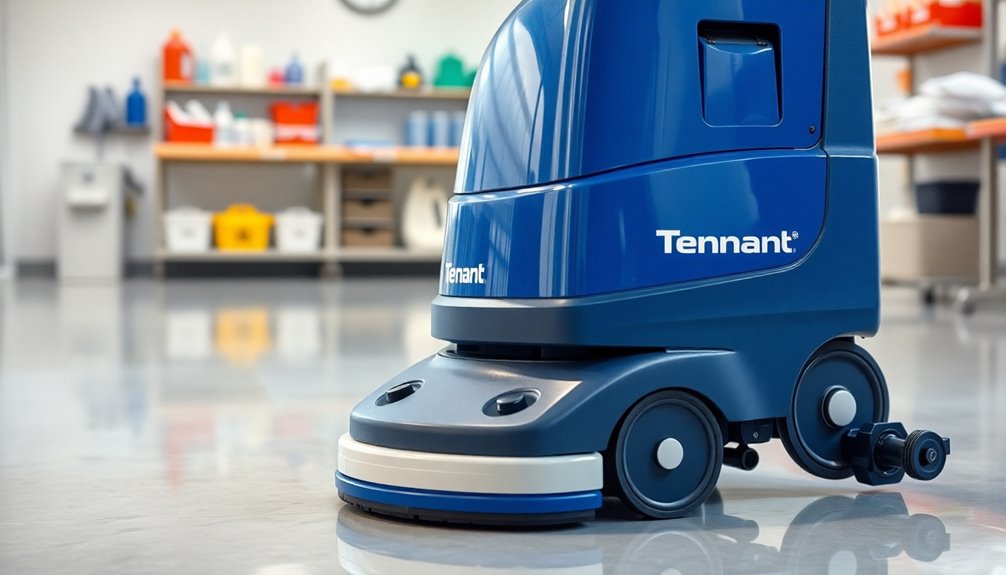
Effective cleaning with a Tennant floor scrubber requires a few straightforward operating procedures.
Start by ensuring the solution tank's filled with water, leaving about 25 mm (1 in) below the fill opening, and add the necessary detergent.
Then, engage the heavy scrub mode by pulling out the scrub head strap and pressing the scrub switch to lower the scrub head.
While scrubbing, adjust the solution flow lever as needed for ideal dirt removal.
Don't forget to:
- Raise the scrub brushes and squeegee after scrubbing.
- Drain and clean the recovery tank for consistent performance.
- Regularly check for debris on the scrub brushes and inspect the squeegee for wear.
Following these steps will help you achieve effective cleaning results.
Post-Cleaning Maintenance

After finishing your scrubbing tasks, it's important to focus on post-cleaning maintenance to keep your Tennant floor scrubber in top shape. Start by raising both the scrub brushes and the squeegee to prevent damage. Drain and clean the recovery tank to avoid clogs. Don't forget to turn off the machine and empty any remaining solution from the tank to prevent contamination.
Here's a quick reference table for your maintenance tasks:
| Task | Frequency |
|---|---|
| Clean recovery tank | After each use |
| Empty solution tank | After each use |
| Inspect battery electrolyte | Weekly |
Also, clean the vacuum fan filter and check the battery levels to guarantee everything operates efficiently for your next job.
Troubleshooting Common Issues

Have you ever encountered issues while operating your Tennant floor scrubber?
Troubleshooting these common problems can save you time and keep your floors looking great. Here are some tips to help you out:
- If the machine won't turn on, check the On/Off key switch and reset any tripped circuit breakers.
- For poor scrubbing performance, verify the solution tank is filled and the scrub brushes aren't worn down to less than 10 mm (3/8 in).
- If the squeegee isn't picking up water, inspect the blade for damage and adjust the deflection for better floor contact.
Regular Maintenance Requirements
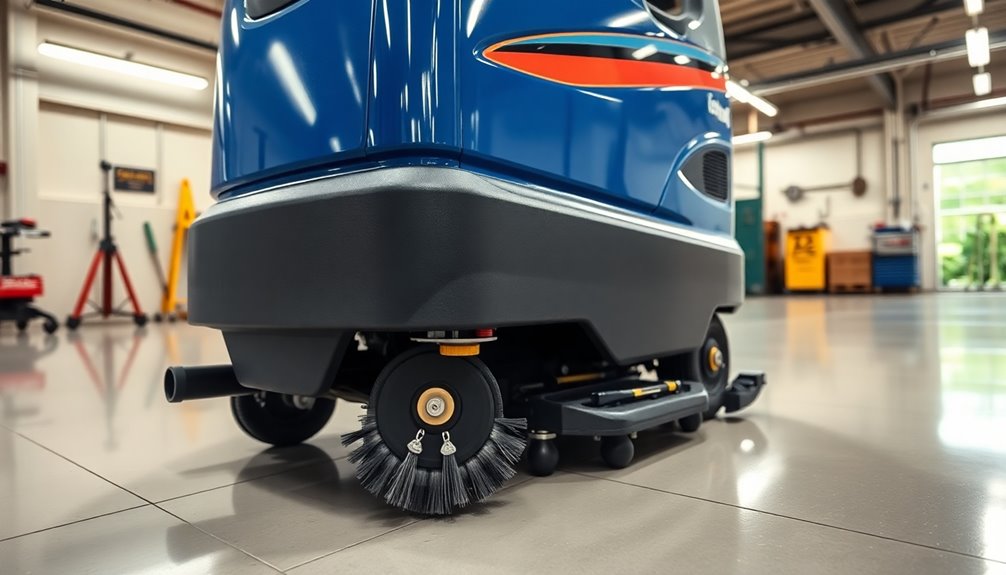
To keep your Tennant floor scrubber operating at peak performance, regular maintenance is essential.
Start by checking the battery charge level while the machine is powered on, and inspect the electrolyte levels when it's off, refilling as necessary.
Inspect the recovery tank for debris and clean it when full, flushing the drain hose with clean water to avoid clogs.
After each use, examine and clean the vacuum fan filter, letting it dry before the next operation to maintain efficient suction.
Check the scrub brushes for wear; replace them if bristles are missing or measure less than 10 mm (3/8 in).
Finally, review service records regularly to spot any additional maintenance needs or requirements.
Frequently Asked Questions
How to Operate a Floor Scrubber Machine?
To operate a floor scrubber machine, start by conducting pre-operational checks for leaks and ensuring all components work properly.
Drive the machine to the area you want to clean, engage the scrub mode, and lower the scrub head. Adjust the solution flow as needed while scrubbing.
Once done, raise the scrub brushes and squeegee, then drain and clean the recovery tank.
Regularly check the battery level and clear any debris from the brushes.
How to Start a Tennant Floor Scrubber?
To start a Tennant floor scrubber, first check for any leaks and guarantee all components are functioning properly.
Open the solution tank and fill it with water, adding detergent while keeping the water level 25 mm below the fill opening.
Flip the on/off key switch to the right to power it on.
Finally, press the scrub switch to lower the brushes and initiate scrubbing, adjusting the solution flow as needed.
How Do You Drain a Tennant Floor Scrubber?
Draining a Tennant floor scrubber isn't rocket science.
First, make sure the machine's off and over a drainage area.
Find the recovery tank drain hose—usually at the back or side—and pull it out.
Let the dirty water flow until the tank's empty.
Once done, flush it with clean water to eliminate any leftover grime.
Finally, secure the drain hose back in place, and you're good to go for the next cleaning task!
Why Is My Tennant Floor Scrubber Not Picking up Water?
If your Tennant floor scrubber isn't picking up water, check a few key things first.
Confirm the squeegee is properly lowered and inspect the blades for wear or damage.
Look for any blockages in the vacuum hoses that could be restricting airflow.
Also, verify that the recovery tank isn't full, as that can cause overflow issues.
Finally, make sure the vacuum fan is working; a malfunctioning fan can seriously impact water pickup.
Conclusion
Now that you're equipped with the knowledge to use a Tennant floor scrubber, you can transform any dull surface into a gleaming masterpiece. Embrace the rhythm of cleaning, feeling the satisfaction wash over you as dirt and grime surrender to your efforts. Remember, every swipe of the machine is a step toward a brighter, more inviting space. So roll up your sleeves, and let your floor shine like a beacon of cleanliness, welcoming all who enter.
